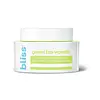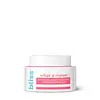What's inside
What's inside
 Key Ingredients
Key Ingredients

 Benefits
Benefits

 Concerns
Concerns

 Ingredients Side-by-side
Ingredients Side-by-side

Water
Skin ConditioningGlycerin
HumectantAloe Barbadensis Leaf Juice
Skin ConditioningPropanediol
SolventButylene Glycol
HumectantCamellia Sinensis Leaf Extract
AntimicrobialRosa Canina Fruit Extract
AstringentAzelaic Acid
BufferingCamellia Sinensis Seed Oil
HumectantPanthenol
Skin ConditioningRosmarinus Officinalis Leaf Oil
MaskingEucalyptus Globulus Leaf Oil
PerfumingSodium Hyaluronate
HumectantCaprylyl Glycol
EmollientGlycolipids
Skin ConditioningGlyceryl Caprylate
EmollientHydroxyethyl Acrylate/Sodium Acryloyldimethyl Taurate Copolymer
Emulsion StabilisingPolyacrylate Crosspolymer-6
Emulsion StabilisingPolyglyceryl-5 Oleate
EmulsifyingCaprylyl/Capryl Glucoside
CleansingSodium Cocoyl Glutamate
CleansingTin Oxide
AbrasiveSilica
AbrasiveCalcium Aluminum Borosilicate
Hexylene Glycol
EmulsifyingPhenoxyethanol
PreservativeEthylhexylglycerin
Skin ConditioningPotassium Sorbate
PreservativeSodium Benzoate
MaskingCitric Acid
BufferingLimonene
PerfumingCI 77891
Cosmetic ColorantCI 19140
Cosmetic ColorantCI 42090
Cosmetic ColorantWater, Glycerin, Aloe Barbadensis Leaf Juice, Propanediol, Butylene Glycol, Camellia Sinensis Leaf Extract, Rosa Canina Fruit Extract, Azelaic Acid, Camellia Sinensis Seed Oil, Panthenol, Rosmarinus Officinalis Leaf Oil, Eucalyptus Globulus Leaf Oil, Sodium Hyaluronate, Caprylyl Glycol, Glycolipids, Glyceryl Caprylate, Hydroxyethyl Acrylate/Sodium Acryloyldimethyl Taurate Copolymer, Polyacrylate Crosspolymer-6, Polyglyceryl-5 Oleate, Caprylyl/Capryl Glucoside, Sodium Cocoyl Glutamate, Tin Oxide, Silica, Calcium Aluminum Borosilicate, Hexylene Glycol, Phenoxyethanol, Ethylhexylglycerin, Potassium Sorbate, Sodium Benzoate, Citric Acid, Limonene, CI 77891, CI 19140, CI 42090
Water
Skin ConditioningGlycerin
HumectantPropanediol
SolventCitrullus Lanatus Fruit Extract
Skin ConditioningXylitylglucoside
HumectantAnhydroxylitol
HumectantTocopherol
AntioxidantCopper Gluconate
Skin ConditioningSodium Hyaluronate
HumectantSqualane
EmollientCucumis Sativus Fruit Extract
EmollientAvena Sativa Kernel Extract
AbrasiveOryza Sativa Bran Extract
Skin ConditioningGlycine Soja Oil
EmollientLecithin
EmollientAloe Barbadensis Leaf Juice
Skin ConditioningCitrulline
Skin ConditioningMagnesium Aspartate
Skin ConditioningSclerotium Gum
Emulsion StabilisingXanthan Gum
EmulsifyingZinc Gluconate
Skin ConditioningHydroxyethyl Acrylate/Sodium Acryloyldimethyl Taurate Copolymer
Emulsion StabilisingDisodium Lauriminodipropionate Tocopheryl Phosphates
CleansingXylitol
HumectantSynthetic Fluorphlogopite
Polysorbate 60
EmulsifyingSorbitan Isostearate
EmulsifyingSilica
AbrasiveTin Oxide
AbrasivePullulan
Isohexadecane
EmollientTetrasodium Glutamate Diacetate
Phenoxyethanol
PreservativeEthylhexylglycerin
Skin ConditioningPotassium Sorbate
PreservativeBenzoic Acid
MaskingSodium Benzoate
MaskingDehydroacetic Acid
PreservativeCitric Acid
BufferingParfum
MaskingCI 77891
Cosmetic ColorantCI 17200
Cosmetic ColorantWater, Glycerin, Propanediol, Citrullus Lanatus Fruit Extract, Xylitylglucoside, Anhydroxylitol, Tocopherol, Copper Gluconate, Sodium Hyaluronate, Squalane, Cucumis Sativus Fruit Extract, Avena Sativa Kernel Extract, Oryza Sativa Bran Extract, Glycine Soja Oil, Lecithin, Aloe Barbadensis Leaf Juice, Citrulline, Magnesium Aspartate, Sclerotium Gum, Xanthan Gum, Zinc Gluconate, Hydroxyethyl Acrylate/Sodium Acryloyldimethyl Taurate Copolymer, Disodium Lauriminodipropionate Tocopheryl Phosphates, Xylitol, Synthetic Fluorphlogopite, Polysorbate 60, Sorbitan Isostearate, Silica, Tin Oxide, Pullulan, Isohexadecane, Tetrasodium Glutamate Diacetate, Phenoxyethanol, Ethylhexylglycerin, Potassium Sorbate, Benzoic Acid, Sodium Benzoate, Dehydroacetic Acid, Citric Acid, Parfum, CI 77891, CI 17200
Ingredients Explained
These ingredients are found in both products.
Ingredients higher up in an ingredient list are typically present in a larger amount.
Aloe Barbadensis Leaf Juice comes from leaves of the aloe plant. Aloe Barbadensis Leaf Juice is best known for helping to soothe sunburns. It is also anti-inflammatory, moisturizing, antiseptic, and can help heal wounds.
Aloe is packed with good stuff including Vitamins A, C, and E. These vitamins are antioxidants, which help fight free-radicals and the damage they may cause. Free-radicals are molecules that may damage your skin cells, such as pollution.
Aloe Barbadensis Leaf Juice also contains sugars. These sugars come in the form of monosaccharides and polysaccharides, folic acid, and choline. These sugars are able to help bind moisture to skin.
It also contains minerals such as calcium, 12 anthraquinones, fatty acids, amino acids, and Vitamin B12.
Learn more about Aloe Barbadensis Leaf JuiceCi 77891 is a white pigment from Titanium dioxide. It is naturally found in minerals such as rutile and ilmenite.
It's main function is to add a white color to cosmetics. It can also be mixed with other colors to create different shades.
Ci 77891 is commonly found in sunscreens due to its ability to block UV rays.
Learn more about CI 77891Citric Acid is an alpha hydroxy acid (AHA) naturally found in citrus fruits like oranges, lemons, and limes.
Like other AHAs, citric acid can exfoliate skin by breaking down the bonds that hold dead skin cells together. This helps reveal smoother and brighter skin underneath.
However, this exfoliating effect only happens at high concentrations (20%) which can be hard to find in cosmetic products.
Due to this, citric acid is usually included in small amounts as a pH adjuster. This helps keep products slightly more acidic and compatible with skin's natural pH.
In skincare formulas, citric acid can:
While it can provide some skin benefits, research shows lactic acid and glycolic acid are generally more effective and less irritating exfoliants.
Most citric acid used in skincare today is made by fermenting sugars (usually from molasses). This synthetic version is identical to the natural citrus form but easier to stabilize and use in formulations.
Read more about some other popular AHA's here:
Learn more about Citric AcidEthylhexylglycerin (we can't pronounce this either) is commonly used as a preservative and skin softener. It is derived from glyceryl.
You might see Ethylhexylglycerin often paired with other preservatives such as phenoxyethanol. Ethylhexylglycerin has been found to increase the effectiveness of these other preservatives.
Glycerin is already naturally found in your skin. It helps moisturize and protect your skin.
A study from 2016 found glycerin to be more effective as a humectant than AHAs and hyaluronic acid.
As a humectant, it helps the skin stay hydrated by pulling moisture to your skin. The low molecular weight of glycerin allows it to pull moisture into the deeper layers of your skin.
Hydrated skin improves your skin barrier; Your skin barrier helps protect against irritants and bacteria.
Glycerin has also been found to have antimicrobial and antiviral properties. Due to these properties, glycerin is often used in wound and burn treatments.
In cosmetics, glycerin is usually derived from plants such as soybean or palm. However, it can also be sourced from animals, such as tallow or animal fat.
This ingredient is organic, colorless, odorless, and non-toxic.
Glycerin is the name for this ingredient in American English. British English uses Glycerol/Glycerine.
Learn more about GlycerinThis is a synthetic polymer. It helps improve the texture of products by adding thickness and gel-like feel.
It is also an emulsifer, meaning it prevents ingredients such as oil and water from separating. It also helps evenly disperse other ingredients.
Phenoxyethanol is a preservative that has germicide, antimicrobial, and aromatic properties. Studies show that phenoxyethanol can prevent microbial growth. By itself, it has a scent that is similar to that of a rose.
It's often used in formulations along with Caprylyl Glycol to preserve the shelf life of products.
Potassium Sorbate is a preservative used to prevent yeast and mold in products. It is commonly found in both cosmetic and food products.
This ingredient comes from potassium salt derived from sorbic acid. Sorbic acid is a natural antibiotic and effective against fungus.
Both potassium sorbate and sorbic acid can be found in baked goods, cheeses, dried meats, dried fruit, ice cream, pickles, wine, yogurt, and more.
You'll often find this ingredient used with other preservatives.
Learn more about Potassium SorbatePropanediol is an all-star ingredient. It softens, hydrates, and smooths the skin.
It’s often used to:
Propanediol is not likely to cause sensitivity and considered safe to use. It is derived from corn or petroleum with a clear color and no scent.
Learn more about PropanediolSilica, also known as silicon dioxide, is a naturally occurring mineral. It is used as a fine, spherical, and porous powder in cosmetics.
Though it has exfoliant properties, the function of silica varies depending on the product.
The unique structure of silica enhances the spreadability and adds smoothness, making it a great texture enhancer.
It is also used as an active carrier, emulsifier, and mattifier due to its ability to absorb excess oil.
In some products, tiny microneedles called spicules are made from silica or hydrolyzed sponge. When you rub them in, they lightly polish away dead skin layers and enhance the penetration of active ingredients.
Learn more about SilicaSodium Benzoate is a preservative. It's used in both cosmetic and food products to inhibit the growth of mold and bacteria. It is typically produced synthetically.
Both the US FDA and EU Health Committee have approved the use of sodium benzoate. In the US, levels of 0.1% (of the total product) are allowed.
Sodium benzoate works as a preservative by inhibiting the growth of bacteria inside of cells. It prevents the cell from fermenting a type of sugar using an enzyme called phosphofructokinase.
It is the salt of benzoic acid. Foods containing sodium benzoate include soda, salad dressings, condiments, fruit juices, wines, and snack foods.
Studies for using ascorbic acid and sodium benzoate in cosmetics are lacking, especially in skincare routines with multiple steps.
We always recommend speaking with a professional, such as a dermatologist, if you have any concerns.
Learn more about Sodium BenzoateSodium Hyaluronate is hyaluronic acid's salt form. It is commonly derived from the sodium salt of hyaluronic acid.
Like hyaluronic acid, it is great at holding water and acts as a humectant. This makes it a great skin hydrating ingredient.
Sodium Hyaluronate is naturally occurring in our bodies and is mostly found in eye fluid and joints.
These are some other common types of Hyaluronic Acid:
Learn more about Sodium HyaluronateTin Oxide is an inorganic oxide used to add opacity and volume to a product. In nature, it is already found in mineral form. The main ore of tin is an opaque and shiny mineral called casseterite.
Tin Oxide helps remove translucency in a product, or make it more opaque. Besides adding opacity, tin oxide is used for bulking to add volume.
Water. It's the most common cosmetic ingredient of all. You'll usually see it at the top of ingredient lists, meaning that it makes up the largest part of the product.
So why is it so popular? Water most often acts as a solvent - this means that it helps dissolve other ingredients into the formulation.
You'll also recognize water as that liquid we all need to stay alive. If you see this, drink a glass of water. Stay hydrated!
Learn more about Water